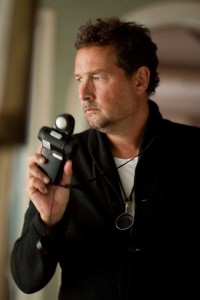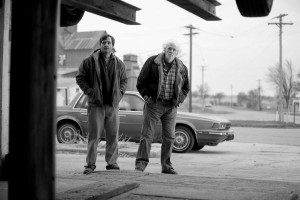
“He picked me up in a Toyota in Billings,” cinematographer Phedon Papamicheal said of director Alexander Payne. They were off to look at “roads, trucks, fields, shops,” trying to understand, and then recreate “this poetic reality of loneliness” for the film they were going to embark on together, the Oscar-nominated Nebraska.
The story is about a cantankerous old man, played by Bruce Dern, who is determined to leave his native Montana and get to Omaha to collect a prize of a million dollars he believes he’s won from a piece of “Publisher’s Clearing House”-like junk mail. Dern’s character insists on going on foot, if he has to, but ultimately takes a road trip of his own with his son, who reluctantly drives him.
Payne, who’d been planning the film since shortly after working with Papamichael on his also-lauded Sideways, wanted to take his cinematographer through the abandoned towns and other facets of the landscape, to capture the “subtleties that worked better in black and white.”

Of course, Papamichael thought the main character worked better that way, too. Upon meeting Dern, “seeing how he looks, his hair, his face,” he found him a “Bergmanesque figure,” and what’s a better argument for black-and-white than a Bergmanesque figure on a stark landscape?
Paramount, however, was “not too thrilled” with the notion, and “actually shut down the picture at one point,” and also reduced the budget, while still insisting on the delivery of a color print as a kind of backup, or to sell to cable.
On the other hand, in the mixed-message department, the studio was good about ordering prints of similarly gray-toned films like Paper Moon. Although he was shooting with an Alexa, watching actual black-and-white film as a reference allowed Papamichael to “set the density” he wanted.
“We determined we could get very to close to black-and-white stock” abetted by use of older anamorphic and Panavision lenses, to give a “filmic, cinematic quality” to the movie.
 Papamichael had only begun to shoot digitally on his previous project, This is 40, for director Judd Apatow.
Papamichael had only begun to shoot digitally on his previous project, This is 40, for director Judd Apatow.
For his most recent film, released as award season unspools, he used a mix of techniques. That would be Monuments Men, George Clooney’s WWII-set “reverse art heist” film. Clooney liked the way Papamichael and Payne worked together on The Descendants, something they replicated on Nebraska, with a small crew, few takes and lingering shots that allow actors movement within them.
Clooney and Papamichael worked together on The Ides of March, and now, with Monuments Men, have a film where the cinematographer was allowed to shoot “day exteriors on film, which renders things a little better,” while using digital cameras, needing less light, for interiors.
Of the “mixed media” approach, Papamichael said, “I didn’t think I’d be allowed to do that.”
But as with his ASC, BAFTA and now-Oscar nominated black-and-white photography for Nebraska, he awaits the envelope while he gets to push it.





